CellRail™
Track side network solution for the provisioning of onboard WIFI connectivity
.jpg) Today, passengers of transportation systems expect similar Internet access to what they are used to at home so that productivity is maintained while in transit.
Providing communications to trains is not an easy task, and the following possibilities can be explored: Today, passengers of transportation systems expect similar Internet access to what they are used to at home so that productivity is maintained while in transit.
Providing communications to trains is not an easy task, and the following possibilities can be explored:
- Commercial Cellular: Although there are several cellular operators, coverage is spotty along the railroad with long lengths of limited or no coverage. Spare traffic availability per cell is limited, so only throughput availability can be expected. Trains will be generally at the edge of cell coverage and communicate at low modulation schemes, consequently reducing the cell capacity.
- Private Trackside Network: This is the best way to guarantee uniform quality andthroughput, but the deployment can be expensive and is only justifiable in high traffic density routes.
- Satellite: Existing Ku-band satellites have low capacity, are congested, and prices are high. New Ka-band satellites should be fully available by the end of 2016 when higher capacity and lower prices can be expected. Due to price issues this solution is sensible only when the other solutions are not available.
 Our CellRail solution explores these three possibilities, routing the traffic so that throughput is maximized and costs minimized. The service offering inside the train also has many challenges and requires a careful design. A single car may require a throughput of 20+ Mbps. The CelPlan solution provides a train throughput above 100 Mbps. Deploying antennas at every car is expensive and a cumbersome for maintenance, so inter-car connections are recommended. These connections have to be economical and high capacity, as they may have to carry additional content, like on-demand video. Our CellRail solution explores these three possibilities, routing the traffic so that throughput is maximized and costs minimized. The service offering inside the train also has many challenges and requires a careful design. A single car may require a throughput of 20+ Mbps. The CelPlan solution provides a train throughput above 100 Mbps. Deploying antennas at every car is expensive and a cumbersome for maintenance, so inter-car connections are recommended. These connections have to be economical and high capacity, as they may have to carry additional content, like on-demand video.
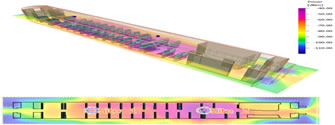 Additionally, technology is evolving at a high pace, and better solutions became available constantly. An effective deployment should use COTS (Commercial Off-The-Shelf) components that can be upgraded/replaced with ease. With all this in mind, CelPlan developed CellRail. It can be customized to customer needs, using different COTS options and can be evolved and upgraded over time. CellRail also provides intra-train communications support for other applications such as PTC (Positive Train Control). The CellRail composition is shown in the diagram below. Additionally, technology is evolving at a high pace, and better solutions became available constantly. An effective deployment should use COTS (Commercial Off-The-Shelf) components that can be upgraded/replaced with ease. With all this in mind, CelPlan developed CellRail. It can be customized to customer needs, using different COTS options and can be evolved and upgraded over time. CellRail also provides intra-train communications support for other applications such as PTC (Positive Train Control). The CellRail composition is shown in the diagram below.
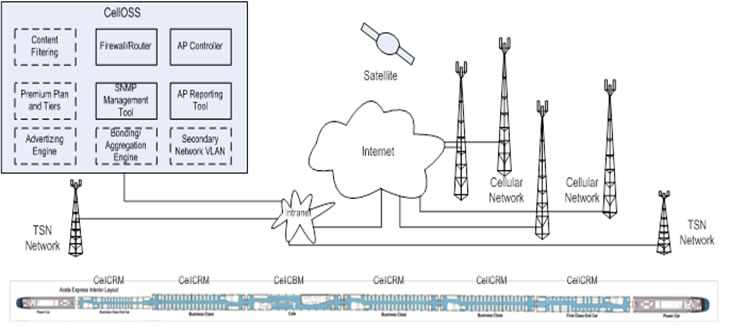
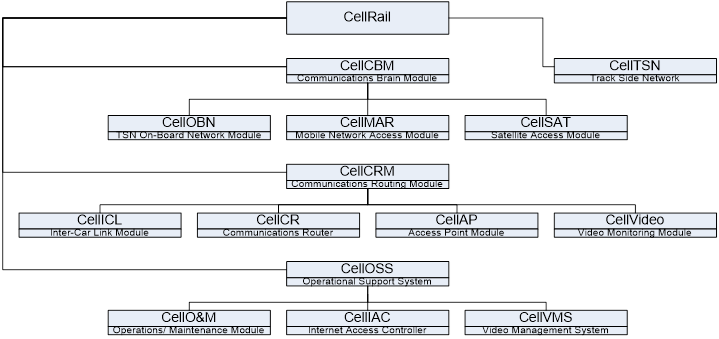
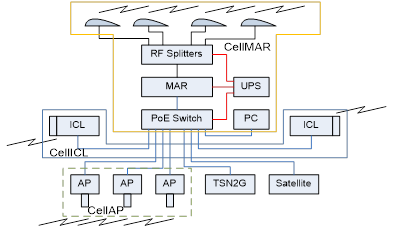
CelPlan has selected for CellRail cutting edge technologies and “Best-of-Breed” vendors in each area. The customer can customize the solution that best applies to its requirements and budget. CellRail modules are described next, including the main COTS vendors that can be configured according to customer needs. Other vendors can be added per customer request or when more advanced solutions became available.
CellCBM is the Communications Brain Module. It can be deployed in a single car or on every car of a train consist. CellCBM supports static and dynamic weighted load sharing, link aggregation, and load balancing.
CellOBN is the onboard part of the TSN network. Vendor options include Radwin or Fluidmesh.
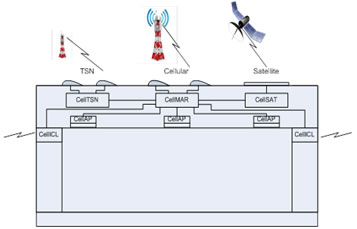 CellMAR is the Mobile Access Router that connects to the commercial cellular networks, besides providing other functionalities. It supports seamless roaming across cellular carriers. Vendor options include Lilee Systems, Mushroom Networks or CradlePoint. CellMAR is the Mobile Access Router that connects to the commercial cellular networks, besides providing other functionalities. It supports seamless roaming across cellular carriers. Vendor options include Lilee Systems, Mushroom Networks or CradlePoint.
CellSAT is the onboard part of the satellite network. Vendors include Hughes and ViaSat.
CellCRM is the Routing Module in each train car.
CellICL is the Inter-Car Link. It can provide a throughput greater than 1 Gbps. It uses radios from Tensorcom (802.11ad), Ruckus (802.11ac) or Cisco (802.11ac). Gbps throughput can only be achieved with 802.11ad.
CellCR is the Communications Router used in each train car. Vendor options include Moxa, Cisco or Transition Networks. CellAP is the Wi-Fi Access Point (802.11a, g, n, ac). Vendors include Cisco or Ruckus.
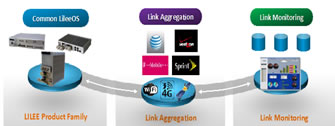 CellVideo is the video processing unit that connects to cameras, stores and transmits video. Camera options include Axis and Pelco. The video processing unit (including storage) is provided by Wi4Net and Dell. CellVideo includes a centralized Video Management Facility that provides centralized storage and visualization panels. VMS vendors include Genetec or Milestone. CellVideo is the video processing unit that connects to cameras, stores and transmits video. Camera options include Axis and Pelco. The video processing unit (including storage) is provided by Wi4Net and Dell. CellVideo includes a centralized Video Management Facility that provides centralized storage and visualization panels. VMS vendors include Genetec or Milestone.
CellOSS is the Operational Support System. It has components in both the train and the centralized hub. CellO&M allows the network supervision and maintenance. It signals when deterioration or failure had occurred and facilitates maintenance. A CelPlan proprietary solution restarts automatically software that stops performing, minimizing the maintenance effort. Software vendors are Wi4Net, SolarWinds, and GBS.
 CellIAC is the solution that controls the Internet Access from login screens to monetization of the service. It has three components: A mobility manager that provides: SIM Management, User Management, Fleet Management, Asset Management, Event Management, Application Management, System Management, Landing Page, History. A train resident software that provides Web Cache (reduces significantly the throughput from the train), Web filter, HTTPS Inspector, and Bandwidth control. A centralized resident software that provides Branding Manager, IpsecVPN, Application control, Virus Blocker, Spam Blocker, Directory Connector, Phish Blocker, Intrusion Prevention, Firewall, OpenVPN, Reports, Captive Portal, and Ad Blocker. These features are provided by Lilee, Wi4Net, RGNets, RaGaPa and Untangle. CellIAC is the solution that controls the Internet Access from login screens to monetization of the service. It has three components: A mobility manager that provides: SIM Management, User Management, Fleet Management, Asset Management, Event Management, Application Management, System Management, Landing Page, History. A train resident software that provides Web Cache (reduces significantly the throughput from the train), Web filter, HTTPS Inspector, and Bandwidth control. A centralized resident software that provides Branding Manager, IpsecVPN, Application control, Virus Blocker, Spam Blocker, Directory Connector, Phish Blocker, Intrusion Prevention, Firewall, OpenVPN, Reports, Captive Portal, and Ad Blocker. These features are provided by Lilee, Wi4Net, RGNets, RaGaPa and Untangle.
CellVMS includes a centralized Real Time Video System (RTMVS) and Video Management Facility that provides centralized storage and visualization panels. It has several video analytics features. The VMS is provided by Genetec or Milestone.
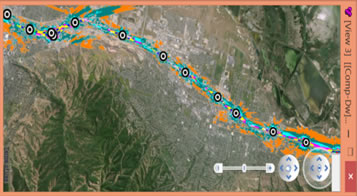 CellTSN is the module deployed along the trackside and provides coverage to the trains. The TSN units are provided by Wi4Net, and the radios are from Radwin or Fluidmesh. CellRail components comply with different standards so that any requirement can be accommodated in terms of performance and cost. CelPlan leverages its 20-year experience in the design of wireless networks. It is in a unique position to design TSN and in-car distribution, by using its CellDesigner and CellTrace tools. CellTSN is the module deployed along the trackside and provides coverage to the trains. The TSN units are provided by Wi4Net, and the radios are from Radwin or Fluidmesh. CellRail components comply with different standards so that any requirement can be accommodated in terms of performance and cost. CelPlan leverages its 20-year experience in the design of wireless networks. It is in a unique position to design TSN and in-car distribution, by using its CellDesigner and CellTrace tools.
CelPlan has an extensive understanding of data application usage by wireless users and the impact that it has on throughput required and network capacity.
CelPlan has an in-depth understanding of the wireless technologies, having published books, given training and webinars. It has published two books about the most advanced technologies.
This gives CelPlan the understanding of the real performance of these technologies and how they are affected by train specific traffic.
CelPlan is known for its in-depth technological knowledge, its capacity of delivering networks in record time and its excellent maintenance and support.
|